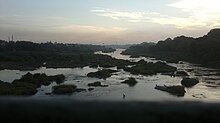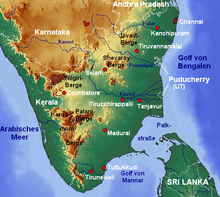Thamirabarani River
This article needs additional citations for verification. (April 2012) |
| Thamirabarani Tamraparni, Porunai | |
|---|---|
Pothigai hills | |
| • coordinates | 8°36′07″N 77°15′51″E / 8.601962°N 77.264131°E |
Srivaikundam[1] | |
| • average | 32 m3/s (1,100 cu ft/s) |
| Basin features | |
| Tributaries | |
| • left | Pachaiyar |
The Thamirabarani or Tamraparni or Porunai is a
Etymology

From the Tamilakam era, the area of the Tamraparni river, in
History

Its many name derivations of Tan Porunai include Tampraparani, Tamirabarni, Tamiravaruni. Tan Porunai nathi finds mention by classical Tamil poets in ancient
In the
A Miami-based Beta Analytic Testing Laboratory published a report on 2021 which claimed that the Tamirabharani civilization along the banks of the river dates back to 3,200 years.[16]
Hydrology

Origin
The Thamirabarani River originates from the peak of the
Course and tributaries
The river flows on the plains eastwards from Papanasam. The first tributary to join Thamirabarani in the plains is the Manimuthar River, which originating from Manjolai hills and joins Thamirabarani near Aladiyoor village. The towns Ambasamudram and Kallidaikurichi are located respectively on the left and right banks of Thamiraparani, after which the river meets the tributary Gadananathi River at Tiruppudaimaruthur. Before the Gadananathi's entry into the Thamirabarani, the Gadananathi River is joined by the rivers Kallar, Karunaiyar and Veeranathi or Varahanathi which joins the river Gadananathi about 1.5 kilometres (0.9 mi) north-east of Kila Ambur.
The Gadananathi is fed by the
- List of major tributaries
| Tributaries | Length | Origin | Joins at | Length of course of Thamirabarani | Dams on the River |
|---|---|---|---|---|---|
| Koraiyar | Mundanthurai reserve forests | Karaiyar Dam | 6 kilometres (4 mi) | Karaiyar Dam | |
| Servalar River | Mundanthurai reserve forests | Papanasam Reservoir | 22 kilometres (14 mi) | ||
| Manimuthar River | 9 kilometres (6 mi) | Manjolai hills | Aladiyoor | 36 kilometres (22 mi) | Manimuthar Dam |
| Gadananathi River | Agasthyamala Biosphere Reserve | Tiruppudaimaruthur | 43 kilometres (27 mi) | Gadananathi River Dam | |
| Pachaiyar River | 32 kilometres (20 mi) | Kalakkadu reserve forests | Tharuvai | 61 kilometres (38 mi) | |
| Chittar River | 80 kilometres (50 mi) | Kutralam Hills | Sivalaperi | 73 kilometres (45 mi) | |
| Ramanathi River | Agasthyamala Biosphere Reserve | Kizha ambur
|
22 kilometres (14 mi) | Ramanathi River Dam |
Drain

The river drains into
Irrigation
The many
The important irrigation channels branching off from both the banks of the river Thamirabarani are, South Kodaimelalagian channel, North Kodaimelalagian channel (Kodaimelalagian anicut), Nathiyunni channel (Nathiyunni anicut), Kannadian channel (Kannadian anicut), Kodagan channel (Ariyanayagipuram anicut), Palayam (Palavur anicut) channel, Tirunelveli channel (Suthamalli anicut), Marudur Melakkal, Marudur Keelakkal (Marudur anicut), South Main Channel and North Main Channel (Srivaikundam anicut). Of these the first seven anicuts were constructed during the period of ancient and medieval rulers and the last anicut namely the Srivaikundam anaicut was constructed and completed by the British in 1869.[23]
List of dams across Thamirabarani river:
- Kodaimelaalagain anicut, 1,281.67 hectares (3,167.1 acres)
- Nathiyunni anicut, 1,049.37 hectares (2,593.0 acres)
- Kannadian anicut, 2,266.69 hectares (5,601.1 acres)
- Ariyanayagipuram anicut, 4,767.30 hectares (11,780.3 acres)
- Palavur anicut, 3,557.26 hectares (8,790.2 acres)
- Suthamalli anicut, 2,559.69 hectares (6,325.1 acres)
- Marudur anicut, 7,175.64 hectares (17,731.4 acres)
List of channels:
- South Kodaimelalagain channel
- North Kodaimelalagain channel
- Nathiyunni channel
- Kannadian channel
- Kodagan channel
- Palayam channel
- Tirunelveli channel
- Marudur Melakkal
Pollution and exploitation
- Mixing of sewage, paper mill and industrial effluents, dumping etc. into the river is a worrying aspect.[citation needed]
- Sand mining in this river was banned in 2010 but it still continues illegally.[citation needed]
- Illegal encroachments of its banks is also a growing concern.
- Pepsi and other Cola companies bottling facility plants were thought to be exploiting the river water, however a court ruling in April 2018 dismissed the allegations and allowed the companies to extract excess water as per the original agreements they have signed.[citation needed]
- Many industries have come in the banks of the river in and around Srivaikuntamthat injudicially use the river water and discharge untreated sewer.
- Untreated sewer of towns like Ambasamudram, Tirunelveli, Papanasam etc. also reduce the water quality downstream.
- Religious practices like letting your clothes along the river at Papanasam as an act to wash sins after a bath has also clogged up the river..
- After the Sorimuthu Aiyanar Temple yearly festival upstream in the forests near Karayar dam the bacteria level in the river increases as thousands and thousands of people bathe at one go.[citation needed]
Fishes
Thamirabarani River is full of fishes and it is one of the
As water flows non-stop throughout the year, it is one of the most fish-rich river in the world where the river is dominated by more than 16 native Snakehead species. It is estimated that nearly 669 fish species found in the river.
Snakehead
Various types of snakehead fish species like
Catfish
Following
Alligator Gar
Alligator Gar is not native to the river but caught sometimes. this was the result of releasing aquarium fish into the wild. on 2015, over 100 Juvenile alligator gar fishes caught and handed over to local authority. Because of the presence of huge number of native Snakehead fishes, the Alligator Gar invasion is not spreading and under control.[citation needed]
Eels
Eels found in this river mainly belongs to
Carp
Carp fishes found in large numbers throughout the river. Three type of carp fishes are
Loaches
Large number of species of sucker fishes found throughout the river. the most common one is
Pangio loach, Schistura loach also common in this river and Schistura is mistakenly treated as snake or eel because of its snake-like appearance.[citation needed]
Others
Other fishes belong to genus ]
References
- ^ "Gauging Station - Data Summary". ORNL. Archived from the original on 4 October 2013. Retrieved 1 October 2013.
- ^ "Thamirabarani". isha.sadhguru.org. Retrieved 14 October 2019.
- ^ Leelananda Prematilleka, Sudharshan Seneviatne - 1990: Perspectives in archaeology: "The names Tambapanni and Tamra- parni are in fact the Prakrit and Sanskrit rendering of Tamil Tan porunai"
- ^ Leelananda Prematilleka, Sudharshan Seneviatne - 1990: Perspectives in archaeology: "The names Tambapanni and Tamra- parni are in fact the Prakrit and Sanskrit rendering of Tamil Tan porunai"
- ISBN 9788175741898.
- ISBN 9788120601611.
- ^ K. Sivasubramaniam - 2009. Fisheries in Sri Lanka: anthropological and biological aspects, Volume 1. "It is considered most probable that the name was borrowed by the Greeks, from the Tamil 'Tamraparni' for which the Pali...to Ceylon, by the Tamil immigrants from Tinnelvely district through which ran the river called to this date, Tamaravarani"
- ISBN 9788120601611.
- ^ The Indian Geographical Journal, Volume 15, 1940 p345
- ^ K. Sivasubramaniam - 2009. Fisheries in Sri Lanka: anthropological and biological aspects, Volume 1. "It is considered most probable that the name was borrowed by the Greeks, from the Tamil 'Tamraparni' for which the Pali...to Ceylon, by the Tamil immigrants from Tinnelvely district through which ran the river called to this date, Tamaravarani"
- ^ Leelananda Prematilleka, Sudharshan Seneviatne - 1990: Perspectives in archaeology: "The names Tambapanni and Tamra- parni are in fact the Prakrit and Sanskrit rendering of Tamil Tan porunai"
- ISBN 81-206-0209-9. Retrieved 6 November 2009
- ^ Robert Knox. 1651. An Historical Relation of the Island Ceylon in the East-Indies. - London. p167
- ^ "Rivers of Western Ghats - Origin of Tamiraparani". Centre for Ecological Sciences. Indian Institute of Science. Retrieved 8 March 2012.
- ^ Mahabharata Online.
- ISSN 0971-751X. Retrieved 23 February 2022.
- ^ "Ambasamudram - Tourism". ambasamudram.net. Retrieved 8 March 2012.
- ^ "Ambasamudram - Rivers". ambasamudram.net. Retrieved 8 March 2012.
- ^ "Rivers of Tamil Nadu". discovertamilnadu.net. Retrieved 8 March 2012.
- ^ "Tirunelveli - Places". Tamil Nadu Tourism Development Corporation. Govt. of Tamil Nadu. Retrieved 8 March 2012.
- ^ "Error -DailyThanthi".
- ^ "Flood in Thamirabarani River, Devotees Banned to Visit Kurukkuthurai Murugan Temple - Serials online SunTv VijayTv Polimer RajTv News". Archived from the original on 11 December 2015. Retrieved 10 December 2015.
- ^ "Tirunelveli District Irrigation". Tirunelveli District Administration. Govt. of Tamil Nadu. Archived from the original on 8 September 2006. Retrieved 8 March 2012.
